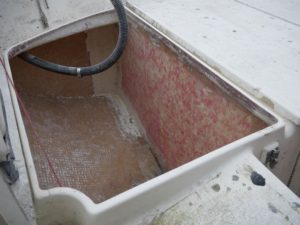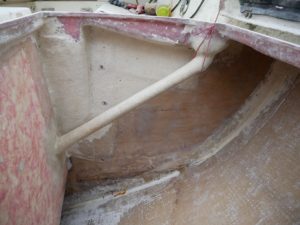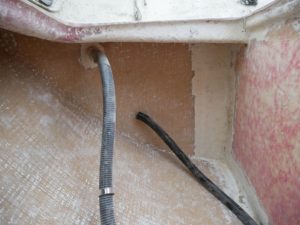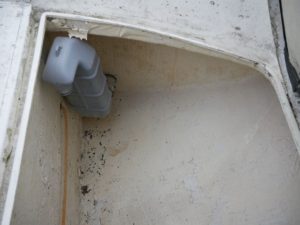Last year, when I started stripping that infernal flaking paint from Fly’s internal hull surfaces, I quickly settled on a electric drill with (mostly) nylon brushes for the job. And equally quickly discovered that some of the most useful looking ones were effectively useless! Nylon cup and pencil (aka end) brushes just melt out in no time, especially if you angle them and/or raise the speed at all (NB all brushes are being used within their recommended speed range because my drill’s not capable of turning faster). Flap wheels aren’t man enough for most paint-stripping jobs although I’ve come back to them for varnish, of which more anon. So my staple has been 4″ orange (coarse) wheels, which have been great on glassfibre but need (even) more care on wood. And I thought I’d learned everything there was to know about orange nylon wheel brushes till something I wrote just days ago proved I hadn’t. I prefer to use them perpendicular to the surface being stripped because they last much longer if you do, but found myself angling them to take the old glue and paint from the forecabin deckhead, then had to keep them angled to avoid grooving the resin. But today I discovered that this grooving is caused not by using the brushes perpendicular (which I’ve done successfully many times) or carelessness (when I’m really pretty careful), but by using them perpendicular after they’ve been reshaped (bevelled) by using them at an angle. And trying to reshape them by angling the opposite way just compounds the problem. So I had a brainwave and trimmed the offending strands back perpendicular with some snips, and all was sweetness and light again. Or perhaps not, because eight hours of non-stop paint stripping can never be described as sweetness and light!
So what of those flap wheels, of which ‘more anon’? Well, I’d been using the blue (fine) wheel brushes for stripping varnish off wood, for which they’re excellent if fast-wearing where the orange ones are really too abrasive, but the blue wheels more than doubled in price overnight while I had several sitting in my Amazon basket waiting to buy and never came back down, with similar apparently permanent increases everywhere else. And, while I was prepared to write off a blue brush in a morning’s work* at less than £6 each, I’m just not tempted at nearly £15! So here was me stumped when I’d been depending on piles of them to make a good job of the wooden surfaces of which I still have plenty to do. But then I remembered the hitherto rejected ‘puny’ orange flap wheels, and have since found them nearly as good (can be used with similar impunity!) as the blue wheels for the job.
*They don’t wear down in that time, but the strands quickly start splaying out to a broader edge that doesn’t strip the varnish so cleanly and easily.
Anyway, enough of that! What have I been doing with orange wheels today?
What you see in the first three photos is what you can do to a cockpit locker if you work non-stop for about eight hours. It’s not finished, but getting there. I was originally planning to try knocking off just the really loose paint (see final pic of port locker for the state of these things!), but soon discovered there’s really no satisfactory halfway house. The wooden bulkhead is to be epoxy-coated like so much else I’ve stripped of dying paintwork, and probably the whole lockers too now. And, yes, the outside of the boat’s filthy even though I cleaned it again last year before building the Noah’s Ark roof over the main hatch!
Nylon brush summary from one year and hundreds of hours use:
- Orange wheels are the most useful overall as well as the most robust, but too abrasive for some softer surfaces and can be compromised by using at an angle. Also impossible to use in narrow spaces and/or where flat surfaces meet at acute angles (obtuse angles are fine).
- Blue wheels are excellent for stripping varnish from wood, but currently unattractively expensive.
- Orange flap wheels are a useful substitute for blue wheels at a saner price.
- Cup or pencil/end brushes of any colour are wasted money when you can destroy them in five minutes.














Just discovered I’d already posted some of what I’d learned about nylon brushes a year ago as a comment to the first post linked above. But I’ve learned more now, so count this post an update!
Comment by admin — 7 August 2018 @ 10:35 pm
Should also have stated my strong preference for brushes with hexagonal shanks (I’ve been using mostly Wolfcraft) because dependable grip in the drill chuck really does make a difference here.
Comment by admin — 12 August 2018 @ 10:37 am